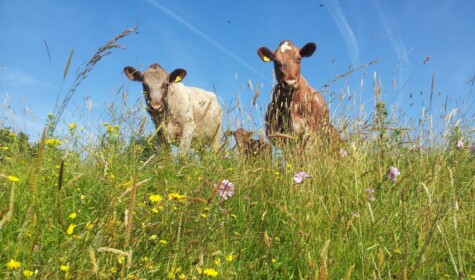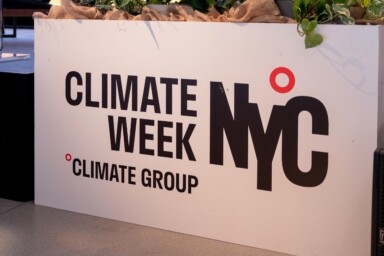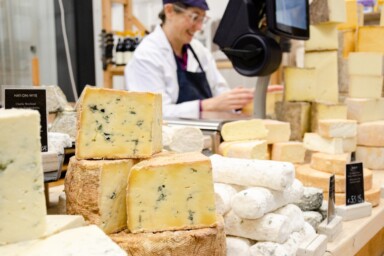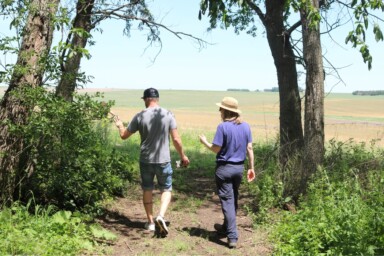How can measuring sustainability help us to understand and value the produce and services that farmers deliver? In this series, we explore the role of metrics in transitioning to a more sustainable food and farming system, and we meet some of the people who are leading the way. Here, Richard Kipling, Head of Research at the Global Farm Metric, explores why a holistic understanding is so important when it comes to measuring and valuing nature, and Bill Grayson, a conservation grazier in North West England, shares his view from the farm.
Valuing
Nature is our life support system – we depend on it for survival in many ways, not least for the production of food.
Human beings do not cause animals and crops to grow, we can only manage the process – and that means that properly functioning ecosystems are vital to the long-term ability of farms to produce food, fuel and fibre.
We know that more biodiverse agricultural systems have a range of advantages over those which are less diverse, from the much greater resilience of yields from multi-species versus single species grasslands to the benefits of agroforestry systems and mixed cropping.
At the same time, productive land as well as field margins and natural areas can be of great value to nature – a traditionally managed hay meadow or unsprayed crop can harbour and support a range of biodiversity and facilitate the movement of species through the landscape. Add in the reliance of society on healthy natural systems for many other ecosystems services beyond food, fuel and fibre, and we can see that farmers and the rest of society should be on the same side in seeking to avoid deterioration in the state of nature on- and off-farm.
It has been argued that taking a lot of care of the systems which grow our food is unnecessary – in the UK many areas of East Anglia have been cropped intensively for decades and still maintain their yields. But as we understand ecological systems better, we have come to realise that, while they can be very resilient, at some level of degradation they reach tipping points at which they flip into new states far less conducive to human life. And our limited understanding means that we can often overlook the signs that something is going wrong, leading us to believe that we can carry on without consequence – as happened with the collapse of the Grand Banks fishery.
To survive, we need to think about how we avoid pushing the systems we rely on over such thresholds, nurturing their ability to resist damage and recover from shocks – and increasing biodiversity is one way to achieve this.
For many people, the way to change our approach is to re-consider how we value nature. But there is a more fundamental value issue here. Globally, nature is being destroyed by intensive farming, often undertaken by farmers who are forced to push their land ever harder by market forces demanding more produce for less reward. In contrast, the life’s work of Elinor Ostrom, who studied the management of common resources like grazing land, water and fisheries, shows clearly that even without external regulation, human communities are more than capable of thriving in the long-term while caring for the systems they rely on.
In the free market, people are expected to act from a narrowly defined materialistic self-interest – they or their firms seek to maximise profit, and in many cases discount the continuation of future streams of benefits in favour of making more now. Greed is good. In contrast, in the communities which successfully conserve their shared resources, a choice has been made to restrain short-term, materialistic self-interest in order to protect the interests of others.
Therefore, while we might seek an economic valuation of nature as a short-term fix, we must recognise that it cannot work in the long-term unless we first learn to value other human beings, including future generations. In a communal species like Homo sapiens, empathy and compassion are as much a part of our natural make-up as self-interest, and that means that we have a choice about how we behave. If we – and particularly our leaders – don’t act to balance self-interest with empathy, we will not value nature as we need to and that risks the collapse our own life support systems.
Measuring
For farmers to act as stewards of nature and of the long-term productivity of their own farms, they need to have some idea of the effects they are having on the natural world. Measuring nature/biodiversity is challenging – the living world is complex and nested, with multiple levels and scales of interdependent systems[1]. We might be able to say that there is ‘x’ amount of this habitat, and ‘y’ amount of another, but how can we know if it is in a good state?
One useful approach is to look at the number and abundance of indicator species for habitat quality – species which are only likely to be present when a particular system is in a reasonable condition. If they are present, our knowledge of that system allows us to assume that things are as they should be, without us having to measure every aspect of nature in the area.
It is also important to evaluate how linked particular habitats are at farm and landscape levels – movement of organisms and genetic material are vital for the long-term health of ecosystems, especially as climate change alters the geographic locations of conditions in which particular species can survive.
New technologies, like the use of satellite data, automated sensors to detect things like bird songs and identification apps on mobile phones, all support the more accurate and faster collection of data about the state of nature, enabling farmers and others to track change. And there is the potential for farmers to draw on local knowledge and expertise to carry out surveys – especially if change can be part of a communal, landscape-scale effort.
Another big challenge is how to interpret farm level data on the state of nature in a meaningful way. For example, is ‘x’ hectares of woodland, or ‘y’ hectares of species rich hay meadow, good? Or is it too little? At what level do we move from good to bad? What types of habitat and what species would be most beneficial in the farm’s location? These questions require an understanding of context, and in turn this raises issues of responsibility. If a farm has poor levels of biodiversity, how much of that is the responsibility of the farmer, and how much the result of external factors like climate change or pollution from the factory upstream?
Seeing the farm as a nested, inter-reliant part of the wider landscape can help determine what types of habitats a particular farm should focus on providing, given what would naturally exist there and the connections between current habitats.
How can all that work in practice? Many organisations are starting to look at enhancing biodiversity and the ecosystem services it underpins at landscape levels – for example Dŵr Cymru Welsh Water’s catchment area initiatives. And the Farming & Wildlife Advisory Group South West have developed and implemented the inspiring Integrated Local Delivery approach to driving environmental improvements, in which the multiple benefits provided by different land uses can be recognised and enhanced in a coherent way, bringing together people that can affect change with the sources of funding which can support it. Farm-level data on the state of nature can be used within landscape scale initiatives to monitor the effects of change off-farm and on-farm, enabling progress to be measured and farmers to be rewarded appropriately.
To value and measure the state of nature on farms as well as the effects of farming on people and the planet, it is important that all involved have a holistic understanding of farm sustainability and of how different types of farm data and modelling can be used to measure it. The Global Farm Metric framework has been developed to provide this holistic, common perspective. It can be used as a map to identify – and explore the interactions between – the state of nature on the farm, its practices, its outputs and its impacts on the wider world, as well as acting as a general guide to farm sustainability.










